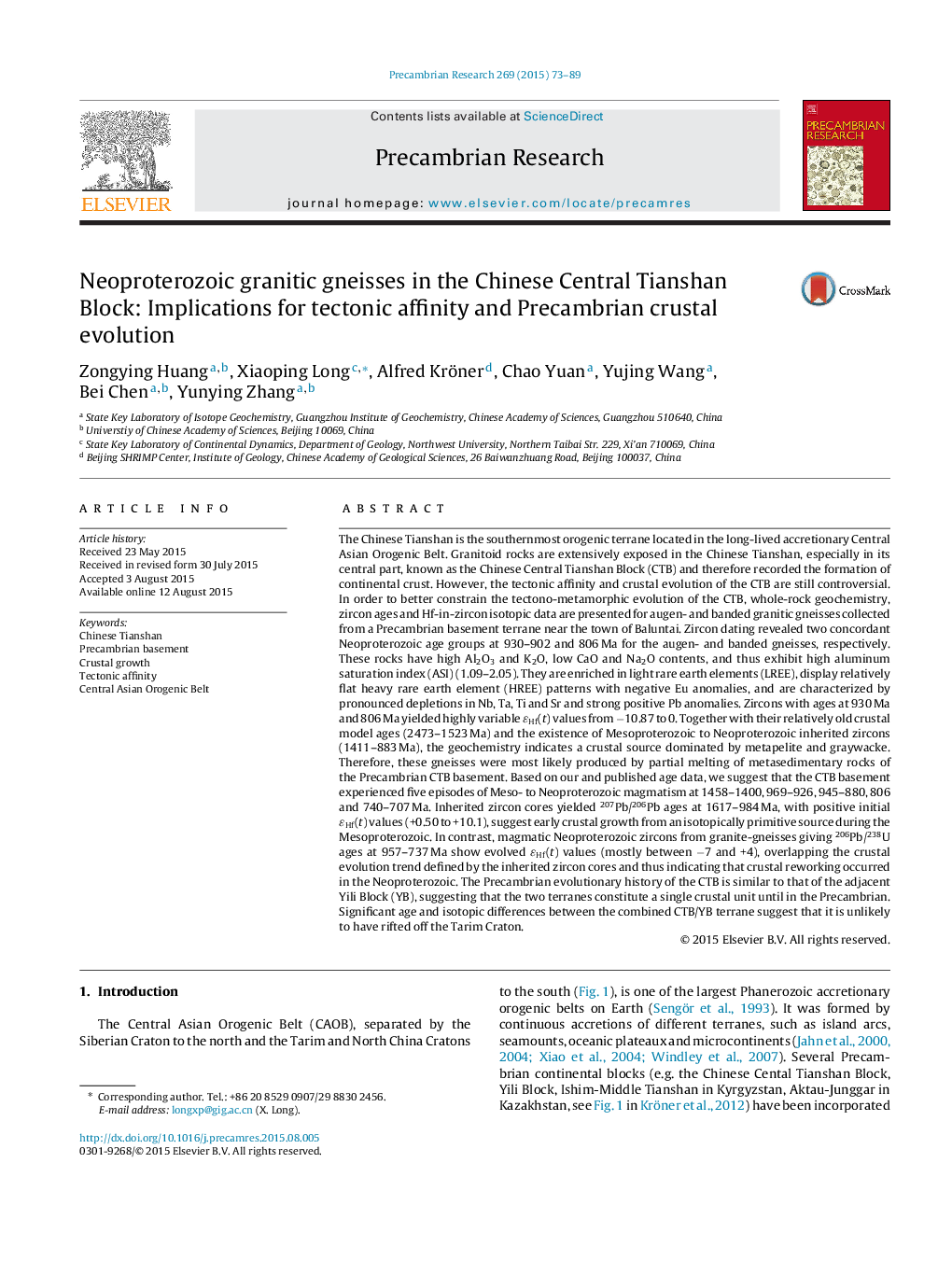| کد مقاله | کد نشریه | سال انتشار | مقاله انگلیسی | نسخه تمام متن |
|---|---|---|---|---|
| 4722570 | 1639606 | 2015 | 17 صفحه PDF | دانلود رایگان |
• Augen- and banded gneisses in the Central Tianshan Block (CTB) formed in the Neoproterozoic.
• The gneisses were produced by partial melting of Precambrian sedimentary rocks.
• The basement of the CTB predominantly formed in the early Neoproterozoic.
• The CTB has a close tectonic affinity to the Yili Block (YB).
• Crustal growth of the CTB basement dominantly occurred in the Mesoproterozoic.
The Chinese Tianshan is the southernmost orogenic terrane located in the long-lived accretionary Central Asian Orogenic Belt. Granitoid rocks are extensively exposed in the Chinese Tianshan, especially in its central part, known as the Chinese Central Tianshan Block (CTB) and therefore recorded the formation of continental crust. However, the tectonic affinity and crustal evolution of the CTB are still controversial. In order to better constrain the tectono-metamorphic evolution of the CTB, whole-rock geochemistry, zircon ages and Hf-in-zircon isotopic data are presented for augen- and banded granitic gneisses collected from a Precambrian basement terrane near the town of Baluntai. Zircon dating revealed two concordant Neoproterozoic age groups at 930–902 and 806 Ma for the augen- and banded gneisses, respectively. These rocks have high Al2O3 and K2O, low CaO and Na2O contents, and thus exhibit high aluminum saturation index (ASI) (1.09–2.05). They are enriched in light rare earth elements (LREE), display relatively flat heavy rare earth element (HREE) patterns with negative Eu anomalies, and are characterized by pronounced depletions in Nb, Ta, Ti and Sr and strong positive Pb anomalies. Zircons with ages at 930 Ma and 806 Ma yielded highly variable ɛHf(t) values from −10.87 to 0. Together with their relatively old crustal model ages (2473–1523 Ma) and the existence of Mesoproterozoic to Neoproterozoic inherited zircons (1411–883 Ma), the geochemistry indicates a crustal source dominated by metapelite and graywacke. Therefore, these gneisses were most likely produced by partial melting of metasedimentary rocks of the Precambrian CTB basement. Based on our and published age data, we suggest that the CTB basement experienced five episodes of Meso- to Neoproterozoic magmatism at 1458–1400, 969–926, 945–880, 806 and 740–707 Ma. Inherited zircon cores yielded 207Pb/206Pb ages at 1617–984 Ma, with positive initial ɛHf(t) values (+0.50 to +10.1), suggest early crustal growth from an isotopically primitive source during the Mesoproterozoic. In contrast, magmatic Neoproterozoic zircons from granite-gneisses giving 206Pb/238U ages at 957–737 Ma show evolved ɛHf(t) values (mostly between −7 and +4), overlapping the crustal evolution trend defined by the inherited zircon cores and thus indicating that crustal reworking occurred in the Neoproterozoic. The Precambrian evolutionary history of the CTB is similar to that of the adjacent Yili Block (YB), suggesting that the two terranes constitute a single crustal unit until in the Precambrian. Significant age and isotopic differences between the combined CTB/YB terrane suggest that it is unlikely to have rifted off the Tarim Craton.
Figure optionsDownload as PowerPoint slide
Journal: Precambrian Research - Volume 269, October 2015, Pages 73–89
